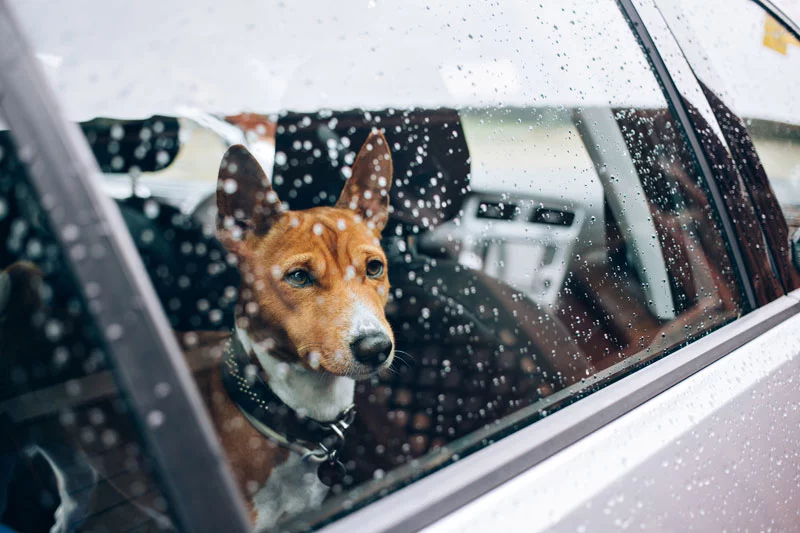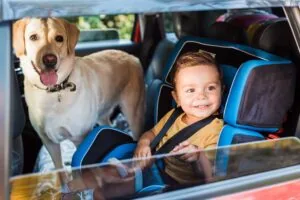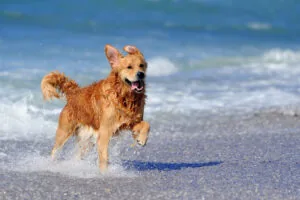Dog Storm Anxiety

Is your dog afraid of thunder? Storm Anxiety can develop in dogs between ages two and four. As your dog grows older, storm anxiety can evolve into hiding, whining, scratching, slobbering or sheer panic. No worries. Your dog may be displaying symptoms of dog storm anxiety. Dogs cannot express their fears in words, and so must communicate in body language that might be difficult for their owners to translate. Possibly because their superior hearing allows them to hear thunder rumbling further away, or they detect other changes in barometric pressure or scents, dogs may begin to react to a storm long before it occurs. Because these changes are indiscernible to humans, it may seem to us that our dogs are simply acting strangely, or even misbehaving.
Some dog owners may try to discipline their pets’ behavior because they don’t recognize the signs of anxiety, which only reinforces the negative association with storms. If we can learn to distinguish the symptoms of canine anxiety, we can not only avoid unnecessary scolding, but we can also take early action to relieve their stress before the storm hits. Symptoms of canine storm anxiety include:
- Lowered ears and tail, wide eyes
- Pacing
- Panting and drooling
- Trembling
- Whining or howling
- Hiding
- Involuntary indoor urination
- Destructive behavior or even self-harm (i.e., clawing in an effort to escape, running away
Common triggers of these symptoms vary from dog to dog, and may change in individual animals as time goes on and their anxiety grows. Some dogs may react fearfully to darkened skies or light rain showers just because they’ve come to associate them with harsher storm conditions.
Other triggers include:
- Changes in smell
- Changes in barometric pressure
- Static electricity
- Wind
- Pouring rain
- Lightning
- Low-frequency rumbling
- Thunder
Relieving Storm Anxiety Symptoms
There is no cure for storm anxiety or noise aversion, but there are several methods to help dogs cope with their fear. While the habit of panicking at loud noises is an easy one to form, reversing this habit often requires a lot of time, consistency, and patience. To avoid severe reactions to storms, animal behaviorists recommend using a combination of behavior modification and fear desensitization before storm season even begins.
The following tips can help your dog cope with storm anxiety:
- Give your dog a safe space. Provide a safe indoor area, like a crate. A plastic crate is preferable – but if you have a wire crate, you can cover it with a sheet to create the feeling of a haven. Leave the door open so your dog doesn’t feel trapped. If your dog is not used to a crate, provide a comfortable, small space like a corner or small bathroom. Be sure to fill it with familiar items such as your dog’s bed, favorite toys and water bowl. If there are windows in the room, close the blinds or curtains or cover the windows so the dog can’t see outside.
- Distract your dog. If your dog is afraid of thunder, play calming music to drown out the thunder claps. If your dog feels like playing, do so. You can also keep your dog distracted with treats and favorite toys.
- Prepare for the next storm. Is your dog scared of thunder? Maybe you should try desensitization. Download thunderstorm sounds and practice by playing them quietly to your dog, and give the dog treats or play a fun game with him while the sound is on. Gradually, over weeks, increase the volume. Stop the play or treats when the sounds are turned off. The goal is to help your dog relate the sound of thunderstorms with happy times.
- Check out products that may help your dog weather the storm. The right product can help calm dog storm anxiety. Tight jackets such as the Thundershirt provide a sensation of pressure, which can alleviate pets’ anxiety. (Swaddling a baby operates on the same principle.) You can also make a DIY version by buying a small T-shirt and putting the dog’s front legs through the armholes of the shirt. The shirt should fit snugly around your dog’s torso.
- Ask your veterinarian. Your veterinarian is the best person to talk to when it comes to dogs and thunder. He or she knows your dog, and will be best equipped to pinpoint exactly which stimulus is troubling your pet. In severe cases, your veterinarian may prescribe medication.
Whether your dog has been struggling with a phobia of storms for years, or you’re looking to prevent a puppy from developing it in the first place, dealing with canine storm anxiety takes a lot of preparation, perseverance, and patience. Just as dogs cannot express the reason for their fears, it’s hard for us humans to explain that we’re trying to help. The best way to communicate our empathy is by doing all we can—through behavior modification, desensitization, medications, or a combination of one or more of these treatments—to help our dogs feel safe instead of scared.
Share This Post
Recent Posts
About Shallowford Animal Hospital
Shallowford Animal Hospital and The Pet Spa at Shallowford are dedicated to the exceptional, compassionate care your pet deserves. Pets hold a very special place in our families, and we treat yours like our own.



